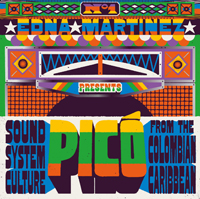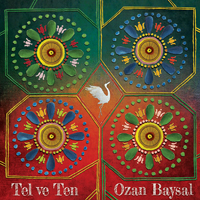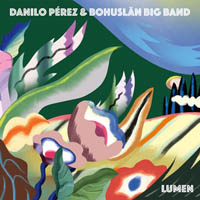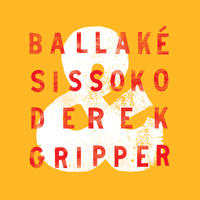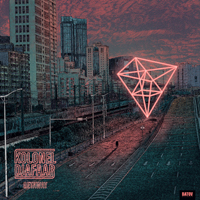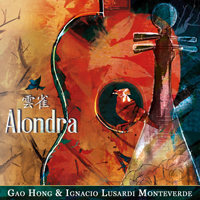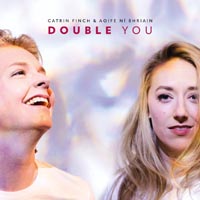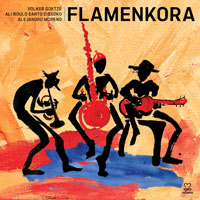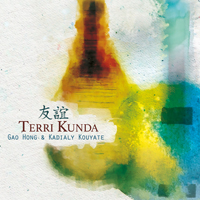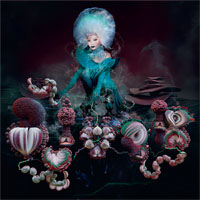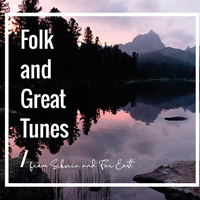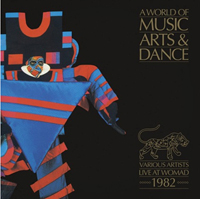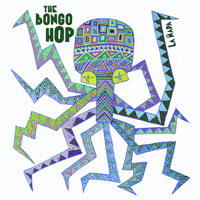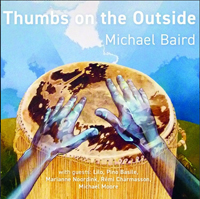 |
Michael Baird is best known as the head honcho of Sharp Wood Productions, the label that has reissued the foundational Hugh Tracey albums on CD, digitally restored, some with bonus tracks we never knew existed. He has also expanded on Tracey's fieldwork with more contemporary recordings from Zambia and his catalogue glitters with gems from top to bottom. Baird is also a percussionist and this album shows he shines in that department also. We are catapulted into a wild journey from "Baonoko Central Station" where relentless rhythms propel us into an aural landscape of moving machines in rapidly changing terrain. I hear train noises, whistles, steel wheels on rails stretching across the savannah. It's all percussion, and the pentatonic gamelan gongs (I think that's what they are) recall Harry Partch's experiments with his Gate 5 Ensemble in the 1950s, as he imagined cloud chambers with giant home-made glass bells. "Resurgent" has a passage that reminded me of Frank Zappa's band the Mothers of Invention. The album suggests myriad possible influences. Baird grew up in Zambia until he was ten, was "repatriated" to England, then moved to the Netherlands (aged 13) where he played in a blues rock band, but Africa is in his veins. This disc is more euro avant-jazz than Zamrock; he has guests on guitar, sax and flute but it's the deep echoing brass bells and marimba tones that make it for me. He also features Italian Pino Basile on cupaphone (I had to look it up), which is like an inside-out cuica. On "Ainu" I hear an electric keyboard and xylophone (again, I am guessing). The Ainu are indigenous Japanese from the deep north with no written culture, and their music has intrigued musicologists for generations as it has strong parallels to the epic songs of West African traditional griots. "Kasai neighbours" continues with a strong rhythmic thrust, suggesting the Congo's likembe rockers, without imitating them. There is tapped bottle percussion and some buzzing rattles and a wonderful distorted lead over marimba, all perfectly mixed into a trance groove. Another meditative track "Radius action" also creates a soothing dreamspace. There is great variety and compelling rhythms aplenty here. |
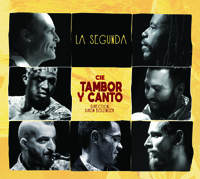 |
Simon Bolzinger is a classically trained pianist who also studied jazz. His passion for South American and Caribbean music led to many outcomes: he started transcribing and arranging orchestral scores from what he heard, and then in 1989 moved to Venezuela where he immersed himself in the music as a performer. Two years later he returned to France to work as a scientist but kept his piano warm. In 1993 he became Artistic Director of the Picante Association in Marseille and by 2005 was arranging annual "Rencontres Tambor y Canto." From these he assembled a musical group, comprising four drummers (who also sing and dance), from Cuba, Brazil, Colombia and Argentina, and a jazz backing of piano, sax and double bass. The company's first album from 2017 was centred in Peru, and for this outing Colombia is the theme, but not exclusively, as Cuba, Brazil and Argentina are also hanging out in the wings. In fact the album kicks off ferociously with Patinho Axé (that's his name, Axé Duckling, which also refers to drum rhythms) declaiming against Bolsonaro and the corruption that is destroying Brazil. The four drummers are already sweating and we are just getting started! We cool down for "Scarborough Fair," the English ballad made famous by Paul Simon, sung in Spanish. It may sound corny but actually is a fine percussive workout. A great Latin jazz rendering of Horace Silver's "Señor blues" with some Yoruba percussion also takes unexpected twists. "Coisas da vida" gets into a serious Brasilian street jam as they declaim they want to be in a "bloco da rua." There's a good balance between the jazz trio and the four percussionists with room for everyone to shine.
|
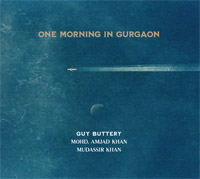
|
GUY BUTTERY, MOHD. AMJAD KHAN, MUDASSIR KHAN
ONE MORNING IN GURGAON (Riverboat Records TUGCD1132)
Guy Buttery is a South African guitar player. Back before Covid shut down the world he was touring India and met the two unrelated Khans (on sarangi and tablas) shortly before their first concert (if the phrase "Delhi traffic" means anything to you, you will understand why they barely had time for a cup of chai and a handshake before their first concert). However they loved playing together so much they met next morning in the same venue to try and recapture the spontaneity of the night before and recorded this in one session. It's a beautiful recording, and not just mucking about with tried and tested riffs, as clearly the unexpected interaction of the guitar and sarangi are bouncing ideas off one another. The dialogue takes a different turn of phrase when Guy picks up an mbira on "I know this place" and Mudassir starts plucking the sarangi, rather than bowing it. There was not much discussion between the musicians, but bits of Hindi and English explained the structure of each piece then it happened in one take. Music has its own language and spirit and the telepathic bond between these artists is superb. Guy lost ten kilos and returned home a vegetarian but with a newfound deep love for the music of India. Indeed he goes outside himself on the two ragas, which are ten minute improvisations; on the second one, "Raag Kirwani," he seems to draw strength from the spirit of Hans Reichel (the German guitarist) when he relishes the sounds of struck rather than plucked strings. |
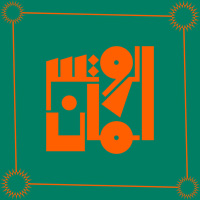
|
THE ROOTSMAN
ESSENTIALS 1996-8 (Akuphone 1030)
This is a two-LP set by The Rootsman, the nom-de-pseud of John Bolloten, a white kid from Brighton England, who grew up on punk before getting a job in a record store in Bradford called Roots Records that specialized in Reggae and Dub. Bolloten began experimenting with DIY sound equipment and then in 1993 someone turned him onto Rai and he immersed himself in that genre. By 1995 he was in Egypt and Morocco where he met Aisha Kandisha's Jarring Effects and began remixing their music for release on his own label. In 1997 he converted to Islam and began collaborating with an artist known as Muslimgauze (Bryn Jones). His punk roots inspired the fury of his pro-Palestinian activism (which, I believe, we all applaud). While he not alone in applying dub techniques to arab music, he does it exceptionally well. This double album is drawn from four of his LPs, Into the Light, 52 Days to Timbuktu, Union of Souls with Celtarabia, and Distant Voices which featured the Disciples as Pachakuti. It is quite mesmerizing. If you like Big Men: Rai meets Reggae or Gaudi's reworking of Nusrat, Dub Qawwali, the work of Cheb i Sabbah or the Spy from Cairo, you will enjoy this. The first side is the most interesting, being the most agitated, then it becomes more mellow after his conversion. Indeed the 1996 album Into the Light, whose first three tracks are included, is replete with catchy hooks, inventive drum patterns, and intriguing vocal samples. The later albums, like Distant Voices show more of the African Head Charge vibe that Adrian Sherwood brought to the UK throughout the 1980s and 90s. By side four it's quite soporific. |
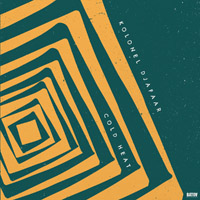
|
KOLONEL DJAFFAR
COLD HEAT (Batov Records BTR050)
Kolonel Djaffar showed up on Bandcamp and, as usual, there is no info to go on. A quick search turns up their facebook page. So they appear to be nine young Belgian guys who are jazz musicians with a funky Afrobeat drummer, and a keyboardist (Farfisa) with a taste for Ethiopian chords. I trust Bandcamp recommendations, for the most part, and felt this stood out. There is a good balance of brass, reminiscent at times of Bollywood Brass Band (!) from London, but with the added bass, guitar and drums. Also trombone and baritone sax are deeply resonant, giving oomph to the bottom end of their mysterious and intriguing melodies. Oddly -- though they have nothing in common -- they also evoke Dengue Fever: I guess it's the mix of keyboard and 70s-rock electric guitar. What we are seeing/hearing is infinite hybridization of "world music" sounds as different groups in different countries approach elements of it, and incorporate instruments and rhythms that work well for them. Back in my punk and new wave days I followed a band called Tuxedomoon who played the clubs in San Francisco; they moved to Belgium after they got a recording contract with Crammed Disc, and never returned. I wonder if their influence lingered, because I get a sense of their moody theatrical approach to the music here. Cold Heat starts with an ominous horn build-up over serious kicking drums, then after a snaky echoey guitar phrase the eerie mysterious organ floats in and a trombone solo persuades us that "Bactrian camel" is indeed the subject. The guitar phrase starts to repeat, the organ too, and then brass layers up the dust storm to a big climax. "Lamentation" is equally tight, suggesting lots of live gigs before they laid it down: this time the Ethiopic organ starts out, followed by a staggered drum pattern before confident charging horns state their intent. "The Heist" even introduces a keyboard pattern that reminds me of gamelan music, adding another musical layer. This is a 16-minute EP, I can't wait to hear more. |
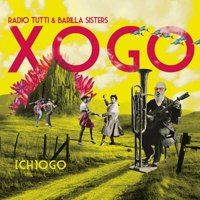
|
Tutti is Italian for everything. As a musical direction it means "all together now," and that's what you get here. The Tuttistas: Baptiste Sarrat (on brass), and Pierre-Alexis Lavergne (on keyboard, guitar, percussion, bouzouki, etc) have teamed up with the Barilla Sisters: Pauline Riviere (on maracas, melodica, tambourine) & Judith Chomel (on accordion, tambourine, etc) and they all sing and dance, whoop and party. Bass clarinet, sax and violin show up from time to time as guests. Their home is Galicia (in Northwestern Spain, where Celts once inhabited the coast) and their music could be loosely termed traditional folk music from southern France and northern Spain, but it is infused with electricity, and doses of Creole (from the Caribbean) as well as "Oriental" (Eastern European) and pan-Mediterranean sounds. The anchoring device is female voices, high and accompanied by slapped pandeiretas, but it is really genre-defying in its scope. There's a Brasilian forro melody (with rap) and an Italian song thrown in for good measure. Xogo (pronounced "shogo") is the Galician word for play. Jogo is game in Portuguese (& Esperanto) and the fun crackles off this disc. The band abounds in talent. I have been enjoying their creative videos on Youtube, such as 2019's "Pizzicarellafro mia," and "Rumba Morena," the lead track from this new album. |
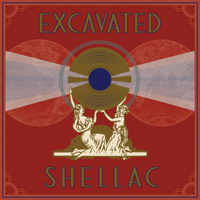
|
EXCAVATED SHELLAC
AN ALTERNATE HISTORY OF THE WORLD'S MUSIC (Dust 2 Digital)
The first time I was overcome with "antiquarian lust" for 78 rpm shellac discs was about 30 years ago, in a bookstore in Portland, Oregon. In the record room, they had a whole section devoted to 78s. I started looking through the neatly categorized albums, seeing Ambrose, Basie, Cab Calloway, Duke Ellington, and thought for a moment I was about to embark on a new area of collecting. Then it occurred to me, all the things I recognized I already had on much more convenient formats, like LP & CD. A friend gave me an album of General Records called VOODOO, recorded in Haiti in the 1940s. So I kept my eyes open for a 78 player, but when I saw one I liked I was in rural England or India and too far from home to think about lugging the mechanism and its giant horn back. The last temptation was again in a bookstore: Serendipity in Berkeley. Browsing on a regular visit I found boxes full of 78s on a table. Now here was something: Coleman Hawkins, early Monk, Lester Young, Billie Holiday. This time I was definitely going to get started. Sorry, said Peter (the owner), Elliot Schwartz has first refusal. This goldmine had belonged to local jazz critic Ralph J. Gleason and after its short-lived stay with Elliot (who died of cancer soon after) I don't know where it went. But in time the shellac past is returning in other formats, like this rich 4-"disc" set from Excavated Shellac. It's another triumphant assemblage by Jonathan Ward who gave us Opika Pende: Africa at 78. And again it has a beautifully designed, legible package, crammed with ephemera, photos and graphic goodies. In the 1980s the Heritage label revived some music from the 1920s, particularly featuring West Africa. From 1996 there was a series of a dozen CDs called "The Secret Museum of Mankind" on the Yazoo label which brought back 78s from different areas. In 2006-8 Savannahphone issued a couple of early retrospectives of Nigerian music, and Buda Musique gave us a compilation of African popular music from 1926-52. Most recently El Sur Records in Tokyo gave us Highlife and Early Congo compilations. My interest in these is because they contain rare African 78s. When it comes to "world music" I am as ignorant as the next fellow. I like African music and music of the Black Diaspora. I also like gypsy music, and some music from the Indian subcontinent, but I am oblivious to Irish, Scots or Breton fiddle or bagpipe music (even though it's "in my blood"), because generally the four-square rhythms don't engage me. Speaking, obliquely, of Northumbrian small pipes, which were played by Thomas Bewick in the late eighteenth century, there's a tune he would have known here: "The Keel Row," which I will sing for you if you buy me a pint (For two pints, I will also sing "Bobby Shaftoe"; for three pints I promise to stop). It's a 1929 recording by legendary Northumbrian piper Tom Clough. There are few artists I know on Excavated Shellac, like San Salvador from the Congo and Salim Abdullah of Tanzania, but it's mostly new to me. The liner notes, which are thorough and document every track in depth, point out the superiority of the recordings on the local Mzuri label as Abdullah's track, "Kwaherini (goodbye)" demonstrates. Abdullah, who formed the Cuban Marimba Band, is justly celebrated and this track is not on the LP which came out in 2019 from Domino Sound, so it's a treat. Similarly the banjo track from Nyasaland (Malawi) is the unique known copy of this recording on the Federal label. The great pioneer Hugh Tracey was making inroads into the territory on behalf of Gallo, looking for such acts. Federal, probably run by Indians, had their records pressed in Bombay! Surprises to my ears are "Riak-Riak" by Toba Batak Ensemble from Sumatra and Vassyl Yemetz's "Z Ukrainskyce Stepiw" from Ukraine.
This is not the kind of disc you put on and listen to all the way though, as it doesn't seem to be sequenced thematically and some of it is harsh. Before the introduction of microphones in late 1920s recordings tended to be loud. But the seemingly odd juxtapositions work occasionally. A sequence of tracks from India, Iran, Uzbekistan, Malaysia and Albania flows nicely. The Malay fiddler would be at home in the Urals we suspect.
Ward admits his collection, like his blog, also called Excavated Shellac, is only a building block and not a definitive canon. There were so many hundreds of thousands of shellac discs released and while most vanished, many still turn up. So if he has found one disc by say, Valentin Eugenio, a folk singer from the Philippines, it's good but not necessarily the best of the dozen sides he recorded in 1931. We just don't know. We do know that popular songs like "All by yourself in the moonlight" by Whispering Jack Smith have not worn well a century later. And if it had not been for black musicians, we'd still be dancing the foxtrot.
The album ends with a Cuban son: the timeless elegance of the sublime "Son la dos, China (It's two o'clock, my china)" by Sexteto Habanero. [Footnote: "China" is also cockney slang for mate, as in China plate!] It stops abruptly as if to say we could keep on playing for ever... or put another way, once more from the top. |
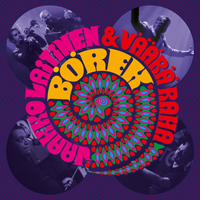
|
JAAKKO LAITINEN & VÄÄRÄ RAHA
BOEREK (Self-published)
Somewhere up there where reindeer graze while recovering from pulling Santa's sledge, they are disturbed from their tranquil ruminating by Balkan music penetrating the Lappish stillness. This fifth album from the trusty lusty Lapps continues to celebrate existence on a musical journey across the world, seen from the Far North and also mainly from the bar car at the back of the train (or "restaurangvagn" as they call it). Jaakko sings and writes the songs, while the other credited musicians are bass and drums, plus trumpet. The trumpeter Ilkka Arola also doubles on all the "other instruments" (there's accordion audible and some smaller mandolin-like string instrument)-- they sing of comings and going, politics, life and death, and warn don't forget your vitamins. That's important when there's a shortage of sunlight and a surplus of vodka. Väärä Raha have won many folk music awards and tour through Germany as far as the Czech Republic on their annual outings. I get a chill just watching "Kotimatka" but do check it out, and this one, "Jumalat jumalat" too. |
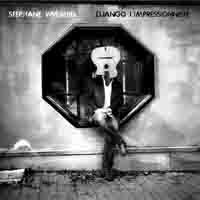
|
STEPHANE WREMBEL
DJANGO L'IMPRESSIONNISTE (Water is Life WIL XIV)
It's well-known that gypsy guitarist Django Reinhardt reinvented the technique of playing after losing the use of two fingers on his left hand in a fire in his caravan. It's also well-established that he elevated guitar playing to the loftiest heights of jazz with his Hot Club de France. He's probably the only non-American to have had a big impact on jazz. I have two different multi-disc box sets of his work so I am familiar with his vast repertoire. When American jazz giants like Coleman Hawkins, Benny Carter and Rex Stewart came to Europe they queued up to jam with him. Other guitarists from Chet Atkins to Andrès Segovia acknowledged their debt to him. Django became to the guitar what Bach is to the keyboard, or Louis Armstrong to the trumpet: if you play, you cannot ignore him. Yet there is more to Django than the swinging gypsy jazz we know and love. Stephane Wrembel learned from gypsy guitarists and exploring Django's vast discography found an overlooked aspect of his creativity. Django had written many classical pieces in the Impressionist style developed by other French musicians such as Maurice Ravel, Erik Satie and Claude Debussy. Wrembel collected these lesser-known solos for this recording, which is a true masterpiece. There are a couple of well-known covers here: Everyone knows the swinging "Tea for Two," and there are two studies "Belleville" and "Nuages" which were written for a film soundtrack. But the others were scattered about in radio broadcasts and live shows and were ignored as studio warm-ups since they did not resemble the pulsating quintet recordings of the Hot Club. Though they have pedestrian titles like "Improvisation no 4" they are self-contained miniatures and hold together as an overall work. Wrembel also noticed that "Improvisation" was not an accurate title as Django played No 4 on a couple of different occasions-- live shows which were recorded-- and it is the same arrangement, so may have developed from an improvisation but was a fixed composition. Wrembel was born in Paris and his playing was featured by Woody Allen in the Grammy-winning soundtrack to his wretched mess of a film, Midnight in Paris, but don't hold that against him. This is an enchanting solo album and I love the mood and understated brilliance of it. |
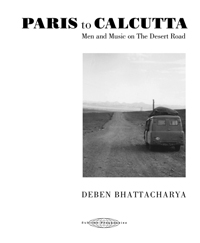
|
DEBEN BHATTACHARYA
PARIS TO CALCUTTA: MEN AND MUSIC ON THE DESERT ROAD (Sublime Frequencies SF112CD)
This 4-CD set and hardback book chronicles a journey made in 1955 when Deben Bhattacharya drove from Europe to his home in India, stopping along the way to record local musicians. Reversing the journey of filmmaker Tony Gatlif's masterpiece Latcho Drom, it shows a kaleidoscopic picture of the Bedouin, gypsies, and other lesser-heard musicians along the route. In 1958 Bhattacharya made an LP compilation (necessarily compressed) from his recordings, but this is the first time the full tapes have been released. In an interview with Guitarist magazine in 1993 Frank Zappa cited that 13-track LP, Music on the Desert Road (Angel Records), with having a huge influence on him. Robert Millis, the man behind Indian Talking Machine, edited the release. Sublime Frequencies, along with Dust-to-Digital, are making considerate and considerable contributions to the preservation of lost treasures of ethnomusicology for future generations.
Deben was a Bengali poet who learned English, Hindi and Sanskrit. He went to England, not for a degree, but to pursue his musical education. He subsequently wrote books about the gypsies and the Bauls, wandering "madmen" singers of Bengal. He promoted Purna Das Baul and the Langa clan of Rajasthan in concert. He was an expert on Indian classical music and in London recorded local Indian performers and sold the recordings to the BBC. With a little capital advanced by EMI for future recordings, his tape recorder and an old Bedford van, he set off overland for home, planning to record Muslim and Hindu music on the way. The driver was a young architect he knew who wanted to go to Chandigarh to meet his hero Le Corbusier (Not surprisingly when they arrived the architect was in ecstasy while Deben was appalled by the Western suburban orderliness of the place and how un-Indian it is). The van was both a home on the road and furthermore the battery could power the reel-to-reel deck. The last disc of recordings in West Bengal are truly lovely.
Outstanding moments are the tar solo by Shapoore Delshadi, recorded in Tehran. Another Iranian, Eskandare Ebrahimi also rips out a stunning improvisation on his setar. Staying in the former British Consulate building in Meshed, Iran, Bhattacharya set up his equipment:
"I had no idea that we would be spending any time in Meshed. But I had got used to changing my plans according to the whims of the road. What else could I do since my mission was to seek for people who improvised music? It always happened that way. If I arrived with letters of introduction, plans, time tables and so on, nothing else would happen. No one would come, not even a braying donkey! Whereas, if I simply arrived, in would come processions of musicians with drums, cymbals, strings, flutes, songs and dances. And as I pushed my battered little microphone right inside their mouths, their songs and dances reverberated through my veins. They sang not only for me but also for the moment which became alive, charged with sound. They improvised and if you were sympathetic, a sharer of sorrow, they expected you to improvise too."
In his career, Deben released over 80 albums of folk music. This distillation gives a taste of the young man embarking on his remarkable journey. ·
|
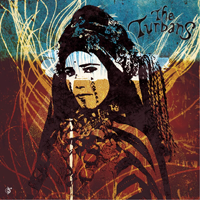
|
THE TURBANS
THE TURBANS (
Six Degrees)
A wide wild array of gypsy-inspired music by a collective who wandered the globe accruing members for a while, busking and playing festivals, until they ended up in a 17th-century Northumbrian bastle house, fortified against Scots marauders. Anyone who survived the trek from Belarus, Greece or Bulgaria congregated in the rustic retreat to make music and between them they composed 30 songs, eleven of which are gathered on their debut album. An Anglo-Iranian fiddler, Darius Thompson leads the group. Baba the Kurd (who got out of Istanbul just ahead of his legend) is the percussionist; Maxim on oud (electric) is from near Chernobyl, so really happy to be freezing in a stone farmhouse in the wilds of England and not glowing in Belarus. There's a Bulgarian rocker on lead guitar and a German rocker on bass, and that's not even half the band, who are all multi-instrumentalists. Kansia on ney gets his turn on his own tune, "Kansianitsa," a nice eccentrically tempoed number featuring his blowing. Pablo Dominguez on flamenco guitar kicks off "Aman," which also shifts effortlessly through key and mood changes into another Balkan-inspired flare up. The disparate elements are well reined in, which makes for interesting segues from one style to another. Simo Lagnawi sneaks in so we are in North Africa for a brief moment catching his krakrebs. The closing number, "Hackney," a song about the ethnic diversity of the London suburb, is a bit hackneyed: I would have preferred no lyrics to stuff like "if you ask your mam where's the best kebab in town? she's going to send you right away to Hackney," etc. Up to that point it's an enjoyable outing.
|
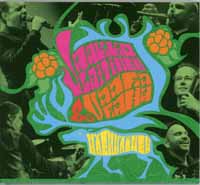
|
JAAKO LAITINEN & VÄÄRÄ RAHA
NÄENNÄINEN (Musilikin edistämissäätiö/Playground Music)
The fourth album from these gypsy Finns will wake you up with a jolt. For a decade now Jaako and Väärä Raha have been tearing up the dancefloors with their mix of Balkan Roma music, Russian romances and old Finnish tango and humppa. To their line-up of accordion, trumpet, bouzouki, double bass and drums, they have added a couple of guests: Macedonian Dane Bjonco Stosic on clarinet and Morgan Nikolay, a Berlin-based balalaika plucker. In addition violin and percussion as well as other guests pop up as the need arises. I am not sure where the "hippie" graphics on the cover come from though I suspect we will see a lot more of it this anniversary year (1967 was the original "Summer of Love"). While adhering to the forms of old tunes, the band infuses them with new life and new lyrics. The best way to preview this is to check out the psychedelic video of the single "Naamioleikki."
|
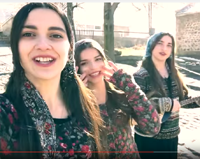
|
TRIO MANDILI
ERTI NAKHVIT (self-published)
Trio Mandili from Georgia, informally known here at Muzikifan World HQ as the Doogly Daggly Girls (thanks to Chris Graham, who alerted me to them) should be taking the internet by storm, so here's my plug for their song "Erti Nakhvit." They have that magical harmony singing we recognize from Le Mystère des Voix Bulgares (remember that album?), coupled with irrepressible youthful appeal whether in ripped jeans and t-shirts or traditional garb, and simple bouzouki accompaniment. They wander about singing in harmony, while the leader makes nonchalant one-take handheld cel-phone selfie videos, mugging and winking at the camera. She is so charismatic you might think she is seeing through time and space to come on to you personally. The self-confident vocals delivered so apparently effortlessly, plus iPhone technology, plus bouzouki equals magic. There's an epic post of all their songs here.
|
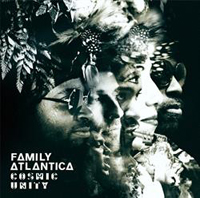
|
FAMILY ATLANTICA
COSMIC UNITY (Soundway CD0082)
This album casts a wide net musically speaking. There are elements from all over: poetry & jazz, hippie thumb piano on reverb, calypso, steel pan, brassy beefy Nigerian funk (especially "La Humanidad"), hiphop, Colombian folklore, even a touch of Incredible String Band in "Blue Atlantic," -- so many that chaos ensues, and I have to skip about and quickly take off some tracks before they piss me off, while others lull me into a false sense that things are going well. I would have placed Family Atlantica in the Caribbean but turns out they are based in London and clearly have picked up on a lot of the international acts coming through, and studied well. I always shy away from singers who are referred to as "divas" -- to me this says vain and egotistical and not open to suggestion. But Venezuelan "diva" Luzmira Zerpa is not always to the fore and the guests include two sax legends: O.J. Ekemode, Orlando Julius himself, and Marshall Allen from Sun Ra's Arkestra. Kwame Crentsil appears on percussion, and Adrian Owusu on guitar, providing a Ghanian funk undercurrent for the more successful tracks. The diva's impression of Toto la Momposina fails to impress me and her poetry and jazz track "Visa" is so bad I could only listen to it once, fortunately I can deselect it in iTunes so I don't have to hear it again -- and the next one too, "Puerta" is unmemorable. Nevertheless the album evinces great energy and has strong percussion and agile saxophony. Surprisingly steel pan works as continuo in the West African funk bits, I think I even hear a string section in there.
|
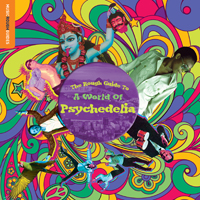 | ROUGH GUIDE TO A WORLD OF PSYCHEDELIA (RGNET910DD)
The new Rough Guide to a world of psychedelia samples various non-mainstream psychedelic sounds and gives us an hour of bands who sound superficially like Country Joe & the Fish or Santana. Now that's there's zero chance of Jefferson Wheelchair reforming it's a great hit of nostalgia for those who like fuzztone guitar as exemplified and amplified on Traffic Sound's "La Camita," a cumbia, which also has wild flute. The closing track "Canto Negro" is also striking and new to me. You probably have all the good tracks, because there's chunks of Bombay the Hard Way ("Piya tu ab to Aaja" sung by Asha -- also known as "Monica my darling" -- or a spooky instrumental by Kalyanji and Anandji) and many other old favorites. It works well as a set, and would be entertaining as a radio show or podcast though whether you need to own it is up to you. "Taxi Driver" by Mlimani Park and Celestine Ukwu's "Obialu be onye Abiagbunia Okwukwe," much as I love them, are not really psychedelic in the way the R. D. Burman or Ros Seresyothea tracks are. Rough Guide have already done psychedelic sets devoted to Africa, Bollywood, Samba, Salsa and Brazil so this is a sampler of their samplers. The three African tracks were already on the Rough Guide to Psychedelic Africa so again it may be duplication or musical overload.
|
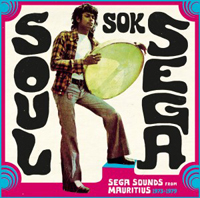 | SOUL SOK SEGA
SEGA SOUNDS FROM MAURITIUS 1973-79 (Strut)
I know nothing about Mauritius except, growing up, we had a large raffia "peacock" chair in the house from Mauritius and my parents joked they had got it on their honeymoon. Not surprisingly Mauritius, despite being about the last place you'd expect to have an indigenous music scene, was deep into James Brown and the funky soul sound in the 70s. This album kicks off with a weird 12-bar blues that is also the title cut, and I must say it's hard to get past. "Far out" hardly begins to describe it. Starting in the 19th century this slave music -- Séga -- was played on a large goatskin-covered drum resembling a tambourine, accompanied by seeds shaken in a box and a beaten metal bar. In the 20th century, after the emancipation of the slaves, European instruments like violin and accordion began to be incorporated into the sound. The lyrics were onomatopoeic and incantatory, sung in creole. Known as "the blues of the Indian Ocean," Séga was banned by the Catholic church and survived underground throughout the 50s and 60s. Elements of its early ritual use survive: the dancers move in a circle and shuffle their feet (as if they were wearing chains) and they often perform around a bonfire because heat is necessary to keep the goatskin drums taut. Claudio's "Bonom Chinois" may sing about a Chinese gentleman but shows clear signs of Bollywood in the arrangement; his "Bhai Aboo" likewise looks East rather than West. "Pop Soul Séga" is a reprise of the opening cut, another 12 bar blues, without the weird Mellotron effect. There are one or two women performers and once in a while the music breaks down to the Séga rhythm which is quite distinctive, though lyrically it shares a lot with another French creole I've been listening to this month: Haitian. But more than anything this music solidifies around the concept of globalism as the influences from all over the world, Europe, North America, the Caribbean and India (a Mohammed Rafi cover), coalesced in the 70s. If you have a magnifying glass the booklet (in 5 point type) by Percy Yip Tong is detailed and tells the story of the music with lots of informative stories about the musicians and their inevitably sad lives.
|
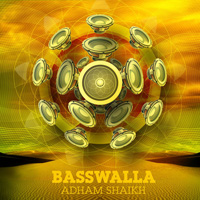
|
ADHAM SHAIKH
BASSWALLA (BlackSwanSounds BS0009)
I put this on and cant think of enough superlatives. I am thinking, Wow, this is gonna be on my top ten discs of the year fo' sho', and I turn it up and groove to the beat of the title cut. Shades of Nusrat as remixed by Gaudi, strong South Asian currents with drum n bass underpinnings, loops and all, but then it starts to slip from the pedestal on the second track "Sabadub (Floating Soul mix)" which goes on too long as the sampled flute turns twee over very basic synth runs. The third track is derivative (definitely trying to do a Gaudi), and it gradually slides further down 'til I am skipping ahead, ready to take it off about halfway through. Shame. It had such potential. Track 7, "Rumba dub" with surprise Armenian duduk intervention offers some variety. The website offers the tags "Deep" "Devotional" & "Dope" for this as well as "Yoga" and "Boulder." Trance dancers and drum n bass fans will like this (as well as kids at Naropa smoking pot and practicing yoga while looking at Tibetan posters) but I think it would work better as a single cut dropped into an anthology to allow some variety, or like a lot of discs, be known for a great lead-off track: a single masquerading as an album. |
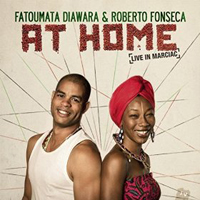 | FATOUMATA DIAWARA & ROBERTO FONSECA
AT HOME: LIVE IN MARCIAC (SP Jazz Village 9570080)
Funky Hohner Clavinet kicks this off and you think at once "Very superstitious", but then some bright Les McCann style piano dashes in and an acoustic guitar playing flamenco. This is Le Jazz Hot in its current incarnation. Fronting it is Malian singer Fatoumata Diawara who has done well to establish herself in another genre because the field of Malian praise-singers and singer-songwriters is packed to bursting. (I am sure your ears glaze over every time I say, "This is another great set of traditional Malian music.") Rokia Traore was on the Cannes jury this year, so it's great to see these ladies getting more respect for their enormous talent and sophistication, not just in songwriting and performing. Fonseca is the keyboardist with the jazzy edge; Diawara plays guitar and sings in more of a soul vein than Malian trad. They met in a nightclub and decided to jam together. They merged their bands and toured for six weeks, culminating in this live encounter in Marciac, France in August 2014. There are a Cuban bassist, drummer and percussionist and added to them is Sekou Bah on electric guitar and Drissa Sidibe on Kamalen n'goni. It's a great blend: the armature is jazz and the Malian guitarist does well to move that way, while the ngoni player sticks to his chops over a rock-solid bass and sporty congas. It's very accomplished, very smooth, and the whole is definitely greater than the parts.
|
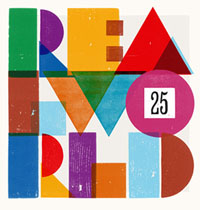
|
It been 25 years since Peter Gabriel launched RealWorld records, a few years after he helped bring off the first WOMAD (World of Music Arts and Dance) festival in 1982. He found an old mill in a quiet English country village and converted it into a state-of-the-art recording studio and invited artists to tarry longer after their WOMAD performance to record for his new label. Now a 3-CD set has been issued to celebrate this monumental achievement. WOMAD itself released a couple of excellent compilation albums, as well as Remmy Ongalla's Nalilia Mwana and Sema, which are long overdue for reissue. Gabriel used his rock-star status to promote world music and it was to his credit that Youssou Ndour and Papa Wemba reached wider audiences, despite what happened to their music as a result. The first release on RealWorld was his own Grammy-winning soundtrack to the film, The Last Temptation of Christ, called Passion, which was followed up by a truly fantastic LP, Passion Sources, that included the raw material he had used to create the music for Scorsese's film. More Ongalla albums followed on RealWorld as his international status was confirmed. RealWorld also found Toto La Momposina in Colombia and Orquesta Revé in Cuba. Not that they were lost, but we didn't know about them. One rainy Xmas eve I was looking for action in Yucatan, Mexico and found a bar with a live band. They were a marimba group and pretty good. I saw another gringo and engaged him in conversation: he told me he was an A&R guy for RealWorld, so we had a great evening comparing notes over cervezas. RealWorld had a great knack of bringing out the best in artists: they recorded a superb album of Hukwe Zawose, the mbira master from Tanzania who also recorded on Triple Earth. When we thought Rochereau had passed his prime (after the departure of Mbilia Bel), he cut a live album in the Box studio which though short was really sweet. Sheila Chandra's "Ever so lonely" was another haunting tune captured in the moment in that Wiltshire village. The list is eclectic and inclusive. I am not sure the 3-CD set works that well, I know some of the tracks really well while some are quite jarring, so I tend to jump about, but if you don't know the depth of the label it is truly impressive. To my mind there's one RealWorld album that sums up their philosophy and also stands far above all the others (certainly in rotation) and that is Nusrat Fateh Ali Khan's Mustt Mustt, with its heavier-than-osmium Massive Attack remix of the title track. This brought producer Michael Brook into the mix, and it spun off in all directions, bringing Qawwali fans to the London dub sounds of Adrian Sherwood and hipper clubbers to the pure strains of Sufi devotional music. Nusrat embodied the spirit of RealWorld with an almost anything goes approach to musical collaboration, yet he always remained true to his self, confident his voice could take it all in stride. More pure Qawwali albums followed and more remixes but Mustt Mustt is the mountain peak. |
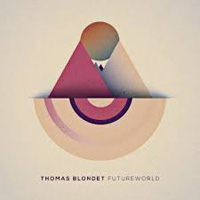
|
THOMAS BLONDET
FUTURE WORLD (Rhythm&Culture RNC027)
Here's another example of music beyond categories, though in this case it is not necessarily a good thing. Initially it reminded me of one of my favorite discs of yore, Putumayo's Arabic Groove. It has been years and I have been "lingering hopefully" -- as Stevie Smith's aunt would suggest -- for something as good to come along. But after some Arabic electronica, it goes Bollywood, then suddenly gypsy brasswards in a cut called "Beyond the Balkans." (Blondet has remixed Balkan Beat Box in the past so that explains his diverse repertoire.) Unfortunately, like too many other albums, it gets flaccid in the middle. Track 6, a wet ballad titled "Tu va partir," is off the rails, but then wait, what is this, Bhangra I hear? "Curry flava," yes that is what it's called. It features M.I.A.'s percussionist. The singer of "Tu va partir," Leyla Chatti, returns for another outing called "In this world," which sounds a bit like Grace Jones from the "Warm Leatherette" era though not a tenth as sexy. I don't listen to much electronica but when I do it must be as good as Cheb i Sabbah or else I bail. Few efforts, outside Gaudi's Nusrat album & some Colombian technocrats, have come near. Blondet skips blithely about with a reprise of the Bollywood number, "Dil da Jani," and a couple of solid King Tubby-style dubs with New York's Subatomic Sound System to end up. All in all it's quite a tour but rather exhausting on the ears. |
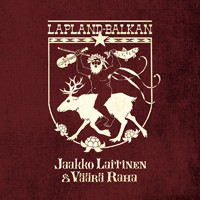
|
JAAKO LAITINEN & VAARA RAHA
LAPLAND-BALKAN (Playground Music)
While the big name Balkan bands are trying to reinvent themselves with gypsy guitar encounters and other collaborative efforts, the Lapps continue to give us what we want: heartfelt soulful Balkan blues, albeit sung in Finnish. The accompaniment is mandolin, trumpet, accordion, double bass and drums. Laitinen is the vocalist and they add strings and guitar on some tracks, but their stripped-down machine, Väärä Raha (which means counterfeit money), is well-oiled and really moves, stopping and starting on a genuine euro dime. I imagine years playing in smoky clubs and bars have honed their chops to a razor edge. The strings enter on "Unta vai totta (dream or reality)" to add a fattened "Egyptian" orchestral wash. Each members gets to solo in the appropriate place: the trumpeter between choruses, the accordion behind the singer. But the stripped down orchestration sounds full as the accordion and mandolin trade licks. A guitar enters for the last track, a ballad titled "Suuren Maailman Suurilla Teillä," which I thought was something to do with the Post Office but means, "You have a great big world." I could say something dumb like "You will lapp it up" or "Lapp dancing was never so hot," or "It's good to the finnish" but there's norway I am gonna stoop to that, instead I will just say, nice work, chaps!
|
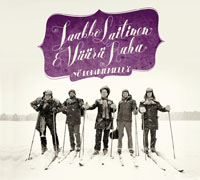
|
JAAKKO LAITINEN & VÄÄRÄ RAHA
YÖ
ROVANIEMELLÄ (Helmi Levyt)
There's a picture of the band with their instruments in the booklet to this new CD that shows button accordion, upright double bass, trumpet and a Turkish hand drum. There are also skis and alcohol: two important elements for those who live in Lapland. This is the second album I have heard by this outfit and I must say it's really fun. It sounds like gypsy music so is either an abnormal manifestation from the frozen north or else there is a Slavic-Romany bond. I also hear bouzouki & kit drums on here. These guys have a lot of zest, which as you can imagine is required if you want to survive that close to the North Pole (though as the rest of us succumb to global warming, the Gulf of Finland will become quite the resort). But don't take my word for it, you can check them out on YouTube and see for yourself how hot they are!
|
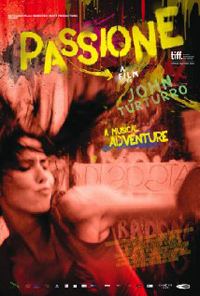
|
PASSIONE
Directed by John Turturro
Naples is a notoriously scary place. The Duchess says you go from one bar to another to try the pizza and if you are lucky you don't get robbed en route. The city is layered and frayed at the ends, like a mountain being digested by the ocean. The people are superstitious Catholics and have been invaded by Greeks, Turks, French, Spaniards, Moors, Americans, and a volcano. If San Gennaro doesn't come through with his miracle annually they expect the worst. But everyone will sing you a song at the drop of a hat, especially if coins are thrown into said hat, so John Turturro went to Naples and started asking people to sing. The resulting film is a delight. It's like a string of music videos, cleverly woven together to tell the story of the evolution of Neapolitan music, from barrel-thumping rituals to scare off malevolent spirits to reggae with arabic rap. It's not really a documentary. Enrico Caruso is mentioned by three old songwriters who debate his merits relative to an older singer who unfortunately did not record in his prime. M'Barka ben Taleb, who raps in Arabic, adds a different interpretation of "O Sole mio," and performs "Nun te scurda (don't you forget)" with Raiz and Pietra Montecorvino (who looks a bit like Keith Richard!), one of the many highlights in this film. Saxophonist Enzo Avitabile explains the miracle of San Gennaro and performs backed by half-a-dozen tub thumpers and metal scrapers. The talented ensemble of singers and musicians also does a local favourite "Dove sta Zazà (Where's Zazà?)," which Turturro explains has been turned into a sentimental ballad about longing for home, when in fact it says, I love you with all my heart but if I can't have you, I'll take your sister. Another highlight is the piano and vocal performance of Gennaro Cosmo Parlato, singing "Maruzzella": he gradually loses it as his girlfriend gets it on with someone else quite publically! It doesn't help he is wearing runny mascara, but the whimpering dog and sex-squeaks adds pathos to the soundtrack. Misia, who is Portuguese, adds some of that Iberian vocal agony to "Indifferentemente," which fans of fado will soak up. She also duets with the leader of Avion Travel. Seeing these performers on the big screen with super sound was fantastic.
|

| JAAKKO LAITINEN & VAARA RAHA (Helmi Levyt)
Now we are off to Finnish Lapland where it's so cold they make their morning tea with boiling vodka. I made that up, but it sounds credible doesn't it? This music will warm you up though: It's predominantly brass band and truly fiery, combining Balkan brass with Russian lullabies and even the indigenous Finnish tango. Recently I read Linnaeus' Lachesis Lapponica which is his journal of his tour of Lapland in 1732 when he was only 25 and had not yet figured out his famous system for classifying plants and animals, but was eagerly traveling around taking it all in. It's a great read and though it's full of insects, smoky huts and the mating habits of reindeer etcetera I found it a fine piece of writing. I wish I had had this album to listen to at the time. Although Ovid himself (2002 years ago, in Tristia) had commented it was "frigging freezing up there!" the locals manage to keep it together with wild music and a rich culture.
|

|
KARTICK & GOTAM
BUSINESS CLASS REFUGEES (EarthSync)
This is described as electro-folk. Kartik & Gotam are Israeli DJs with a passion for Indian music. Gotam was from the desert and Kartik from the big city and they tried to bring the ambient sounds from their respective backgrounds -- swirling sands vs hubbub of traffic -- to bear on Arab songs. Their debut with Hebrew rap music was not an auspicious beginning. But then they heard some singers at a Tajik wedding and their ears were opened. They have brought some Carnatic classical musicians to jam with the Tajiki singers and accordionist. The result is an Indian-sounding album with a 60s pop sensibility in some of the experimental ideas. The opening cut made me think of John Lennon's groundbreaking psychedelic ditty "Tomorrow never knows" (on Revolver, 1966), with double-tracked vocals through a whirling Leslie speaker and razor-spliced tape loops. A decade later Brian Eno saw the potential in this one-chord "raga"-like riff & recorded it with Phil Manzanera on the 801 Live album. The Lennon-Eno nexus is an important one for experimental music and their ideas are still worth exploring. K&G's electronica, with some rock drumming, is a good basis for the flights of fancy of the Indian musicians on flute, violin, tablas, etcetera, but it does degenerate into a rock-and-rolly free-for-all from time to time ("Shiva sheva"), and bad pop ("Door open door"). I wish they had left off the samples of airline stewardess instructions to passengers -- it's irritating, not cute -- and the snippets from yoga tapes, which do not induce relaxation when they are repeated over a funk groove reminiscent of Beck, Bogart & Appice's "Superstition"! By the end it really goes down the tubes, which is too bad. The Indian musicians deserve better: maybe Cheb i Sabbah will do a Carnatic album next.
|
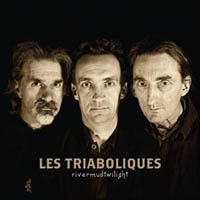
|
LES TRIABOLIQUES
RIVERMUDTWILIGHT (World Village 468088)
I don't review much white music, not that I am a racist, I am just niggardly with my auditory space and dont like to explore beyond the types of music I enjoy: African, and music of the African diaspora, even though I occasionally listen to other types of music -- jazz, pop and rock -- that I don't need to write about here. (I put niggardly in that last sentence because one of my students insisted it is a racist word: amazing how ill-informed the younger generation is! Comes from all that mind-numbing rap music they listen to!) I should appreciate Celtic music as it is in my genetic code, but I don't. However I put on this new release by Les Triaboliques and really enjoyed it. It reminded me of Jerry Garcia's side project Old and In the Way, then Fairport Convention and the unplugged early Led Zep stuff like "Black Dog." I imagine these guys, who must be in their sixties, have similar musical backgrounds to mine. John Renbourne, Bert Jansch, & the Bonzo Dog Doo-Dah Band played my college in London in 1968; everyone was listening to American blues, as reflected in the folk and pop music of the 60s. Ben Mandelson and Lu Edmonds, two of the triaboliques, or "Les Diaboliques," were part of Three Mustafas, a brilliant band I was fortunate to see in concert. They were like the Bonzo Dog of world music, and very entertaining. And when you think of clowns turning to legit theatre late in their careers, like Bill Irwin, or Robin Williams and Steve Martin doing "Waiting for Godot," you understand the longing to show what they can do with a straight face that has driven the Mustafas to doff the fezes and kick out the jambs. The mandolin playing of Ben Mandelson is a highlight as he embroiders the melodies. They cover "Don't let me be misunderstood," which was a hit for the Animals, and "Jack O'Diamonds," an old country & western ballad. The other tunes are original compositions but show their feeling for music of other lands. The third member is Justin Adams whose work I am not familiar with, though I believe he has gigged with Robert Plant, but I won't hold it against him. They are all excellent string players and this is a rich and varied album.
|
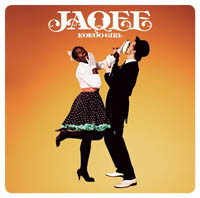
|
JAQEE
KOKOO GIRL (Rootdown Records RDM13065)
I get bogged down trying to like albums I really can't get into, and spend more time than I want trying to find the right mood for a disc in my in-box. So after giving up on Lily Storm's set of Eastern European laments and the terminally dull drubby arab dub of Omar Faruk Tekbilek, I put on Jaqee, not knowing what to expect. It sounds like a Skatalites album. It is a heavy ska-reggae style disc, very lively, with wonderful singing from the aforementioned Jaqee. She is from Uganda but now lives in Sweden where she released her debut album Blaqalixious in 2005. She has gone from soul and R&B to blues and even did a Billie Holliday tribute album. She is clearly trying on different musical hats to find where her future course lies. Backed by Koalas Desperados, renamed the Kokoo Nuts for this outing, who play solid old-school reggae, she has put together a lively set of 12 originals. Obvious touchstones are Millie Small, Marcia Griffiths and Dawn Penn. It's a very upbeat album, and even ends with a reggae spiritual, "Healing waters."
|
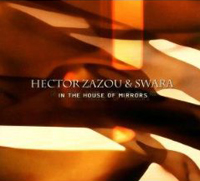
|
HECTOR ZAZOU & SWARA
IN THE HOUSE OF MIRRORS (Cram 47)
I have mixed feelings about Hector Zazou. No, that's not true, I have always despised Hector Zazou! Back in the days when I was Papa Wemba's Numbah One American Fan, I bought an expensive imported LP that was a meeting between Wemba and Zazou. I paid big money for it and after listening once I dumped it. Then I learned that Zazou was one of those world music meddlers who finds perfectly good music and has to fiddle with it, adding synthi swashes and so on. This was also the turning point in my undying admiration for Wemba. So when Crammed sent me an advance copy of this (instead of the Kasai All Stars I had been hoping for), I hesitated to put it on. But, you know some old dogs can learn new tricks, or at least their old tricks can become more polished with time, so I gave it a listen and it was not half bad. I played it for the Duchess who being younger than me has more tolerance for programmed music, and finds it helps her concentrate at work. She liked it, saying she has an album called Sahara Blue by him. Zazou died recently so this is his last album. They say dont speak ill of the dead, but that is an absurd statement: the dead are the last to care what you say about them. Did he finally get it right? Zazou assembled a group of Indian master musicians and they float in and out of the wash and, by jove, it works. There is an overall integrity to it. After a decade of listening to Rahman who really excels at portmanteau music, it's okay to have a drum loop and drone, as long as there is someone with talent playing live atop the mix. And unlike Eno & Byrne whose return to the Bush of Ghosts sounds like they have been cryonically frozen for 20 years, this is an evolved sound, sophisticated & subtle. Nevertheless the groundbreaking work of Eno & Fripp, as one exceptional pair of collaborators, set the stage for a lot of this incidental music for loungers. While there are whispers of Paul Horn inside the Taj, and other new agey elements, the overall impression is good; it would work well as the soundtrack to a film.
|
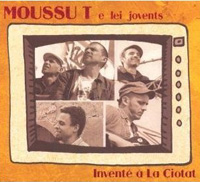
|
MOUSSU T ET LEI JOVENTS
INVENTE A LA CIOTAT (Chant du Monde 2741549)
I was a bit puzzled by this disc because it only the second thing I have seen from this band yet it seems to be a career retrospective with nothing new and a lot of reworking of their one "hit"-- or catchy ditty more accurately --"Mademoiselle de Marseilles." Not wishing to dismiss it out of hand I played it for my pal Big Steve, a confirmed Francophile. His first thought was how much the rest of the world owes to American popular music. You can hear New Orleans all over this! He said. Yes, and blues and pop, I added. But then I mentioned to him that half the album was repeated from their previous album and the remainder was scraped together with two versions of one song and a DVD. Steve enlightened me: Remember Wayne Fontana and the Mindbenders? he asked. They had a hit, recorded an album and then put out a Greatest hits album which was everything left over from their first session grafted onto the bit of it that people had liked. This seems to be the same story. I put on the DVD and the band comprised a singer, a banjo player and a drummer. All of the other stuff -- rhythm track, jews harp, smoking electric guitar -- was coming out of a machine. Chante du Monde is a respectable label with a great catalogue of folk music from all over the world, but not this one: save your money for something else.
|
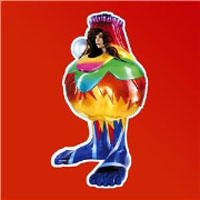 |
BJÖRK IN CONCERT
SHORELINE AMPHITHEATRE, MOUNTAIN VIEW 19 May 2007
When I put on Björk's new album VOLTA last week, I could tell her concert was going to be a return to her tribal punk roots. She has come a long way since the Sugarcubes and reinvents herself constantly, but stays on the edge of performance art and musical exploration. We missed her tour with the symphony orchestra, Inuit chorus and harpist, as the tickets had sold out in a flash, but when the Duchess got wind of a new tour she had her connections working on the necessary digital synapses to get us tickets. The minus side included paying a 40% service charge to those Nazi pimps Clear Channel so we ended up with $100 tickets that still put us 200 yards from the stage at the impossible Shoreline Amphitheatre in Mountain View. The plus side was a fantastic show that went off flawlessly & had us bopping about in the chilly Bay night air.
Shoreline is built on the site of a dump and to get there you drive round and round (past Google HQ!) and end up in a dusty field far from the venue. It is one of the reasons the San Francisco Bay is no longer the largest in the world, having been filled in with garbage over the past century. Famously, during a Steve Winwood concert, a fan's cigarette butt set fire to the methane that seeps from the dump and the place nearly burned down. The opening act was going on and on so everyone could find their spot. Any other crowd would have rioted and booed this crap outta there, but the warbling harpist got polite applause which only encouraged her. She had a wispy girly voice and a wispy girly band. Looking around we could see the crescent moon rising in the night sky with Venus burning brightly below it.
As I predicted Björk came out with the opening cut of the new album, "Earth Intruders," an Oompa-Loompa groove with a jagged percussion beat on two-tone African cowbell and primal thundering synth bass lines. The stage was dimly lit like an aquarium but you could make out three keyboard/computer players, a drummer, and a ten-piece brass section comprised of Icelandic ladies, dressed in flimsy pastel gowns. Each of them had an orange flag attached to her back, so as they moved and grooved the flags bobbed about like dayglo fish. It was reminiscent of the samurai cavalry in Kurosawa films: no doubt Björk is an admirer of Emi Wada, Kurosawa's costumer. Behind them were huge pastel banners with fish and toads on them. Despite the largeness of the stage it was packed with equipment, monitors and gizmos and giant television screens that showed what at first looked like computer games.
Björk ran through four songs from her new album. Mercifully she did not do the ill-conceived song about the lady suicide bomber (not what you want to think about in a crowd of 12,000), and she also did not bring "Anthony" (of Anthony & the Johnsons) who sings duets with her on the new albums, effectively ruining it as a listening experience. What was she thinking? Yes she has a strange voice, with her thick accented english, and an odd manner of phrasing, but that is her charm. Anthony is a drippy almost creepy crooner of the Pat Boone junior league that makes you tear the album off.
It's said that Konono Number 1 is on the new album. There is a bit of ragged cowbell in "Earth Intruders," but no electric likembes I could hear. In fact this is one of her strategies. She mixes four sonic elements: percussion, a tape loop or samples, a keyboard that may be another synthesizer, and a fourth element that could be a guest with a kora, harpsichord, gamelan, or Chinese pipa. On this tour a ten-piece brass section was the fourth component. But the brass band was mixed as one sound which was a shame as I wanted to hear all the individual horns. They were really fine in unison and once or twice the trumpets got to do a little improvisation. It was a tightly choreographed set so there really wasn't a lot of the spontaneity or interaction you expect in a live show, nevertheless it was a treat. The volume was massive and when she went into "Pagan Poetry," the crowd erupted. There were a lot of lost Middle Earth people wandering about in silly costumes and they stopped long enough to jump up and down for this rallying cry. But then they went back to wandering the aisles lost and consuming $10 beers. There was so much pot smoke in the air it looked like fog in the light show laser beams.
After each song Björk would say "sink yew" and curtsey, and then she tried on a "mooshas grassyass" which got quite a laugh. There was no banter which was too bad, just a black-out followed by the video games on the big screen and then the rhythm track of the next number would kick in. Gradually you realised the video game was a computer screen that was generating the sound through physical manipulation. You would see the hands & fingers of one of the musicians touching the green screen and he would manipulate the syn-waves physically. I don't know what this instrument is, some kind of clever interface, but it was fascinating to see him distort and bend the rhythms, & Björk was too far off to really see what she was doing unless she was flailing her arms and feet in her unique way, signalling that she never learned how to dance.
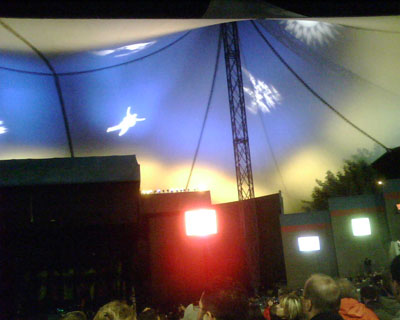
cel-phone snap by the Duchess
My references are probably out of date but I recalled the experiments Brian Eno was doing with Cluster in the 70s, Pere Ubu came to mind, and of course Massive Attack. My favourite song on the new album is "Wanderlust." She saved that for late in the set by when you could hear the nuances in the brass and the others were not overhyped so there was a little space in the wall of sound. Björk recycles fragments of her past tunes and some of her melodies, so you think you know a song but it has been reconstructed. "Wanderlust" has a lyrical vocal line, the brass swells poetically with contrapuntal phrasing as the insistent fragmented samples (little furry creatures pawing gravel) sets up a rhythmic contrast.
Björk is up to six albums and is off on a leisurely world tour. I didn't like her last outing, Medulla, and I am glad she has gone back to the sound of her successes from Post, Vespertine, and Homogenic. I didn't take notes but it was not a roster of hits by any means. The Duchess found the set list on a tour blog. She did "Aeroplane" from her first solo album DEBUT. From POST she did "Army of me," "Hyperballad" and the sublime "All is full of love." HOMOGENIC provided "Pluto," "Five years," and "Unravel" and VESPERTINE got short shrift with only "Pagan poetry." On "I miss you" Einar Orn got to show off some chops with a great jazz trumpet solo.
One of the band, keyboardist Jonas Sen, has a tour blog which contains insight into the music from the stage. Apparently they had not rehearsed two of the tunes, "Aeroplane" and "Mother Heroic," which they tried out just one hour before the show. From our side of the stage, it already had a finished sheen.
The encore was also carefully planned. She performed "Oceania," the song that she had written for the Athens Olympics. I remember waiting through all the crap of the opening ceremony to hear it and the minute she started singing the asshole announcers on the TV network started talking about the number of yards in her costume, and the number of extras in the piece, etc. It was a mix of tango and cha cha rhythms and a great departure. She ended with the other militaristic number from VOLTA, "Declare independence." There was a hint of Mark Smith of the Fall in her delivery of this song. It ended with a bang and a flourish and flames shooting into the sky, burning off the methane in the landfill dump below the stage.
|
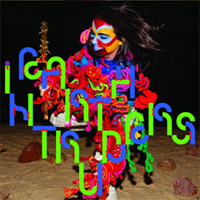
|
BJORK
EARTH INTRUDERS
"Earth Intruders" was the single from Bjork's album VOLTA. It was also released as an EP with four club mixes. If you buy the album on iTunes you can skip the duets with Anthony which are insufferably wet and the song about the Lady Suicide Bomber, and add the remixes to make a better album. For that matter you can also add in "Mama na bana" from Konono Number One's LIVE AT COULEUR CAFE to get the full effect as she is jamming with them, though their sound is buried in the Björk album. This is Björk's sixth album, and though she feels she has to reinvent herself completely each time, this is a return to a more primitive kind of punk (albeit with very slick sidemen), and makes for great get-up-and-get-down music. It's accessible, brassy, and above all rhythmically propulsive.
|
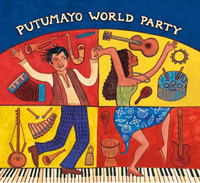
|
PUTUMAYO WORLD PARTY (P263-SL)
There are three or four really good songs on here that you are not likely to find elsewhere. As usual it's a short (44-minute) Putumayo sampler, and travels from Martinique to Denmark, Ghana, Benin & Jamaica, to North America and Argentina. Roy Paci from Italy (Sicily I think) is the opener, with "Ciuri Ciuri" a catchy ditty in a ska stylee, and this is followed by Jean-Philippe Marthely, Jean-Paul Pognon & Jean-Luc Guanel from Martinique doing "Wote Monte," which has a zouk & compas feeling to it. The other Caribbean tracks, Burning Spear's "Walk" and Orchestre Tropicana d'Haiti's "Gason Total" make this worth hearing, and remind me why I love that lilting island music so much. Laurent Hounsavi from Benin turns in a credible African salsa number, like he's trying out for Africando. The other stuff is less appealing to me, though it's curious to hear Osibisa doing "Sunshine day" again. It does sound quaint. Overall the disc is chirpy and a bit too relentlessly happy but that's party music and more precisely the Putumayo sound which we now recognise. Light and bubbly. Check this out if you get a chance; samples available on Putumayo's website.
|
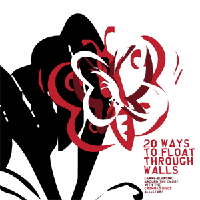
|
CRAMMED ALL STARS
20 WAYS TO FLOAT THROUGH WALLS (Crammed Disc CRAM129)
Crammed is one of the best world music labels extant. They love gypsy music and they champion the electric thumb-piano bands of Kinshasa, so they are tops in my book. In addition the small indie Belgian label has been putting out samba, Brasilian fusion and even rock albums for its 20 years of life. Six of my top albums of the last couple of years are sampled herein: there's Konono no 1, Mahala Rai Banda, Kocani Orkestar, Taraf de Haidouks, and tracks from Congotronix 2 and Electric Gypsyland 2. The set kicks off with Apollo Nove's "Traz um alivio," a short and sweet tropicalista ballad sung by Tita Lima with an electronic psychedelic mood. This segues into Tartit from Timbuktu with their manic droning and repetitious bass, tindé drums and plucked string instruments: about as far from the sleek Brasilian sound as you could get. But we don't wait long as it cross fades into Wise in Time, an urbane British folksinger who recalls Family from the 60s. The other acts included also hold surprises: a great cut from DJ Dolores --"De dar do"-- that reminds me of the type of pagode that used to get me worked up when I was resident in Salvador da Bahia. Then there's my guilty pleasure: Tuxedomoon. I know it sounds like a character from a Japanese anime (but I am not admitting to liking that!), however Tuxedomoon were one of my favourite post-punk bands in San Francisco in the 70s and I would religiously attend all their gigs (and those of the Mutants) when Winston Tong was their frontman. They always had interesting musical ideas, mixing pseudo-classical viola with new wave bass and drums and throwing in odd things like soprano sax in an experimental jazz-pop blend. I still have their EPs buried somewhere with my Factrix and Negativeland albums. They haven't grown up but still retain a cheeky freshness. The Duchess was surprised I played this all the way through as there are some wet bits (Cibelle's samba or the sodden take on the Beatles' white album by a Frenchman called Hugo) I would normally race to eject but the mix is intriguing and I will always give some credence to a deejay who can make the leap from a sleek club remix of Taraf de Haidouks to Kasai All Stars with their primitive buzzing and rattling onslaught. It's a great introduction to the small eclectic label that deserves worldwide exposure for their taste and dedication.
|
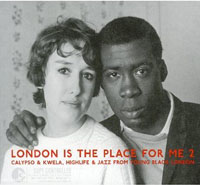
|
LONDON IS THE PLACE FOR ME 2
CALYPSO & KWELA, HIGHLIFE & JAZZ FROM YOUNG BLACK LONDON (Honest Jon's Records)
I believe this series is already up to four releases in the UK, however number 2 has finally made it to the USA. It is different from the first volume in that, in addition to calypso, we hear other music from the era when folks from the colonies migrated to London in the mid-twentieth century. It boosted the British jazz scene immeasurably because suddenly you had real African & Afro-Caribbean musicians bringing rhythms and different musical idioms to what was essentially copycat music, at one remove, from American jazz. Among the black community you would find West African drummers jamming with Caribbean hornmen and a whole mélange of talents playing in clubs, town halls and even for anthropology students whose notion of African music was what they heard in films when you saw wild Zulus with spears attacking the plucky redcoats with their Lee Enfield rifles. The album starts surprisingly with a calypso by Young Tiger that is a critique of Bebop, which he doesn't get. His backing is pure smooth jazz: "They call a man a 'cat' and a girl a 'chick,' and they're up to all kinds of shady tricks, with their oop-badda-ba boop-badda diddly-a!" In "Gerrard Street," King Timothy visits the same club and discovers he can't dance to it, "Mister you really should stop: You only beepin, when you should bop!" The detailed liner notes give a history of Ambrose Campbell, one of the overlooked pioneers of black music in Britain, who migrated from Lagos in 1940. His laid-back number "Yolanda" is a gem. We also hear him with his West African Rhythm Brothers on four selections. Kitchener pops up with a great calypso "Come back with my wife's nightie"! The Lion does "Kalenda March," probably the only track on here you have heard before (It's on his SACRED 78s CD as "J'ouvert barrio."). I think the new context enhances your appreciation of the backing band on these old calypsos. It's certainly great to hear them interspersed with various African tracks like Ambrose Campbell's "Ashiko Rhythm," which might otherwise get overlooked. LONDON IS THE PLACE FOR ME 2 is handsomely packaged, digitally restored and essential listening.
|
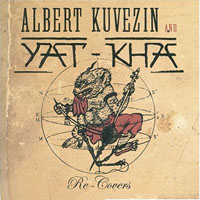
|
ALBERT KUZEVIN & YAT-KHA
RECOVERS (World Village 468061)
When I was a kid I used to make "music" by playing spoons, water glasses, tapping on beer bottles & in extremis, blowing into a vacuum-cleaner hose. When I hear a didgeridoo or the Tuvan throat singers, I remember the fun of making those gravelly noises that sound like a sick bear woken from hibernation. Yat-kha are Tuvan superstars with a sense of humour who have done punk songs and have just recorded an album of heavy metal covers that is quite possibly the worst album ever recorded. I will have to listen to it all the way through, but after a few seconds of "When the levee breaks" I skipped to the next track and then killed it, not even getting to what I suspect will be the nadir: "In a gadda da vida," a song that should surely be forgotten as quickly as possible. Second try: Kuzevin's weird English emerges fully on Hank Williams' "Ramblin Man," and he makes a farce of Ian Curtis's tragic "Love will tear us apart." I can only conclude that Ben Mandelson, who produced this, is having us on. Is this actually a 3 Mustaphas album? Who knows, anyway it is truly awful. Perfect for getting those unwanted guests to leave when the party's over.
|

|
MOUSSOU T E LEI JOVENTS
MADEMOISELLE MARSEILLES (Chant du Monde CDM068)
This could pass for Cajun music, or even rural blues. It's hard to pinpoint where it's coming from. They sing about Marseilles but those are surely Africans on the cover. Also the name of the band suggests creole. But the music is varied and there's a lot of creativity. Moussou has one of those whiskey-soaked voices that will remind you of an older generation, like Paolo Conte, but the music sounds older still, as if you are in the France of the thirties and black music has just arrived in the form of jazz and beguine. A quick trip to their website reveals that they blend Antillean and Provençal music with Brasilian percussion. The banjo is a main instrument and, with an accordeon, there's a jaunty sea shanty air with a whiff of the oily backstreets of the seaport too. The title cut is really catchy and when it ends it staggers off leaving only an urchin belting out the refrain. "Bolega Banjo" gets dubby with party time percussion and discoid guitar. It reminds me of dark little waterfront bars you stagger into to get out of the rain and suddenly find yourself buying drinks for surprisingly attentive young ladies. Before you know it you are dancing like a fool, thinking where's my wallet? where's the nearest exit? all the while moving and grooving knowing you look uncool, while resisting the effect of the alcohol. "Si j'allais en prison" takes a tilt at boogie with the guitarist dusting off his Elmore James impression. OK, ladies just one more... pour la route! The last track, "Soulomi" brings things down to a nice atmospheric dream and shows that Moussou and his youngsters have much more up their sleeves.
|
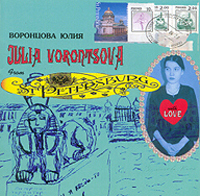
|
JULIA VORONTSOVA
FROM ST PETERSBURG WITH LOVE (Abaton Book Company #011)
This may be hard to find but is worth tracking down. A very mellow album of Russian folk music with a surprising rockabilly edge to some of the songs, it was a pick to click on Charlie Gillett's recent SOUND OF THE WORLD compilation. Although Vorontsova sings above her range and doesn't project a lot, there's an engaging quality to her voice and she plays a mean fingerpicked ax. Her upper-register straining lends an endearing quality of fragility to her songs. Charlie says she was applauded for her witty lyrics and even without understanding them you can appreciate her delivery. The mood of the CD is very intimate and there's a synopsis of each of the songs in the booklet, which has original drawings by the singer in it. Here's a sample: FABERGE. "This song is about the house in St Petersburg where Fabergé would produce his famous eggs. My friend's balcony was facing that house. This is a short song. Most of my songs are short.
And once again on a sleepless endless night
do you know what will come to my mind?
You, my most cherished sacred dream,
and a duet for voice and sorrow."
|
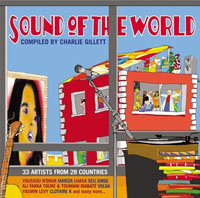
|
SOUND OF THE WORLD (Wrasse Records 169)
I am so sick of compilations. To me most compilations seem like the province of newbies. The compiler cherry-picks the obvious greatest hits from a genre and then spits them out as a definitive look at African blues, Malian blues, Latin dance favourites, Best of Slick Salsa, Best of Sloppy Salsa, or whatever. I listen to those that come my way, and even review them in print, but I usually know all the good songs and am not particularly intrigued by the obscure cuts. Therefore it was a great pleasure to get SOUND OF THE WORLD, a double-disc set put together by BBC radio DJ Charlie Gillett. Charlie is in a good position as he not only gets EVERYTHING but even gets to hear stuff not available to us mortals. For example he recently got invited to Russia to judge a music festival and some of his discoveries from that trip provide the most interesting moments on this new set. Of course being a DJ is not that easy. I mean you don't need any actual musical ability, though it helps. Mainly you need an ear to pick out what's new and original and then to find the cut that is going to click. I have DJ friends who only try the "side one track one" approach. If that doesn't set their foot tapping, they forget it. "Wow, what's that great song?" they ask me. "It's the second cut on the B side," I tell them. So it's work, and often you dismiss an album because there's only one good song then are glad when it shows up on a compilation and wonder if you should have tried harder. But life's too short to be listening to mediocre albums over and over trying to find the good bits in them.
The first disc kicks off with Daby Balde from Senegal. Not a familiar name but this cut will have you looking for the album INTRODUCING DABY BALDE (on Riverboat records) to see what else is on there. Next up is Bulgaria and the first of the "gee I didn't know those white people had so much soul" moments. Actually it's Boris Iliev's clarinet that sets this apart, and the vocal by Sissy Atanassova is great, reminding you of those other gypsies, the ones that appear in Bollywood production numbers! OK cue the video on this one! But track three, "Geo" by Ivan Kupala from Russia, is the first that makes you grab a pen and say I have to write this down-- RADIO NAGRA-- must try to find this album (try http://www.soyuz.ru).
I know many of you will disagree but I thought Amadou and Mariam were crap in concert with their French rock band and though Amadou plays a good R&B guitar, Mariam's vocals were shrill and the din was awful. Every time the djembe player stepped forward the trap drummer decided to outdo him. I liked their previous two albums, but I didn't keep their Manu Chao-produced album DIMANCHE A BAMAKO. However the best cut from it, "Coulibaly," is on here. It is followed by the first one you are going to either love or hate, Camille, a French singer who wants to be Bjork but settles for Jacqueline Brel. I hit the forward button. The next one starts like Miles Davis' "Elevator to the gallows" and I am thinking we are in for some more weird French time-warp crap, but then an arhythmic drum comes in with some dubby bass and I know Mr Gillett has been clubbing in France & it is, well, kinda interesting. There's a hip hop feeling to it but the best part is the stretch between the jazz trumpet of Ludovic Venu and the Wolof vocals of Jean Gomis (a relative of Rudy?). The group is called, inexplicably, Meï Teï Shô. Streets of Laredo ranchería is up next with a Canadian woman of Mexican extraction named Llasa. I imagine if you caught her act, you might dig this. On the other hand if she appeared on Sabado Gigante she might get the hook. Now I am getting an itchy trigger-finger and zip forward to Darko Rundek & Cargo Orkestar with a good cut from RUKE (on Piranha) which I enjoyed. (I went looking to see if I had reviewed it and found I had rubbished last year's Charlie Gillett compilation, so things are definitely looking up!) After some bad rap from Nairobi Yetu (at least it's in Kiswahili), the first disc mellows out with State of Benghal vs Paban das Baul, followed by the first encounter between Ali Farka Toure and kora player Toumani Diabate and then the jazzy reggae of Anzacs DJ Fitchie and Joe Dukie, who give us "Midnight Marauders," with a solid horn chorus. (The Duchess found it boring and asked me to take it off.)
Disc two starts with Issa Bagayogo, top of the pile where he belongs. Brazilian flava-of-da-month Seu Jorge pops up for a moment with his squeaky cuica accompaniment. On the recommendation of two different people I watched The Life Aquatic with Steve Zizou to see Seu Jorge. He was awful (David Bowie covers? Forget it!) and the movie really stank, or sank. The first thing that catches me by surprise is Shukar Collective. I didn't know you could actually imitate Lee Perry! But this second disc gets very slack and I venture could have been left out entirely. True, there's Youssou Ndour, but we all have that album EGYPT as it's the best thing he's done in decades. Ana Salazar from Spain does the "Ay-yi-yi-yi" chorus which you can hear at any soccer match. (Though recently at a forgettable Premiership game in England I noted that "Guantanamera" has become the most popular melody for fans to co-opt.) By the time we get to Japanese horns doing "Jingle bells" (Tokyo-chutie-iki's "Otome sankabi") I feel like I am wasting my time. I hate the shotgun approach: pack the CD with lots of stuff and someone's bound to like some of it. The consumer isn't fooled by the offer of "buy one get one free." Quality not quantity is what we want. The last cut by Think of One is a Belgian-Morrocan collaboration with another big nod to Jamaica. It's a good ending, but the most interesting stuff on here is by the Russian artists Gillett has discovered. Someone might consider a Best of Russian New Wave or whatever and ask him to compile it and open up another frontier to us music fans.
|
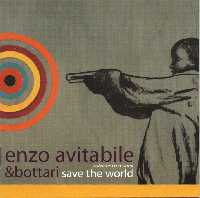
|
ENZO AVITABILE & BOTTARI
SAVE THE WORLD/SALVAMM'O MUNNO (Wrasse Records WRASS124)
There's a peculiarly Italian way of singing that sounds like an endless litany of complaints. You probably know it from Paolo Conte, and, if that's your thing, there's plenty of gruffness and griping here. Enzo has a commanding presence, however, and this is a very engaging album: its success due equally to the stellar roster of guest artists who appear and bring their varied talents to the project. Khaled and Amina sing, Manu Dibango and Hugh Masakela toot their horns. Best of all is the pervasive presence of Simon Shaheen on oud and violin on four tracks, Baba Sissoko on kamelengoni on a few tracks, Adel Shaaher on tar on three tracks, and the occasional sound of the ney, zurla and sax. It makes for a lot of variety that sustains your interest. The driving rhythm is also intriguing. This album of Neapolitan music has a raft of guys beating on barrels and tubs (instead of drums), and clashing scythes together. I bet it gets the spiders out of the tubs before the new wine goes in. This tradition started in the 14th century to drive out evil spirits form the farm and also augur a good harvest. It's a weird mechanical clacking sound and sets up a metronomic beat that is quite hypnotic. This is unlike anything you've ever heard, I'm sure, but you will get hooked by the second listen.
|
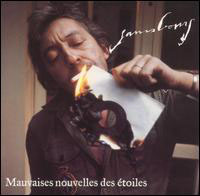 |
SERGE GAINSBOURG
MAUVAISES NOUVELLES DES ÉTOILES (Sunnyside SSC3692)
DeeJay IJ arrives with a bag of goodies, or so he represented it to me: stuff he thought was great and worth checking out, though when pressed he admits he is passing on other people's assurances and hasn't actually listened to it himself. I waded through the bag and there were some pleasant moments but also a lot of dross. I tried hard with three albums, one was Keb Mo's BACK BY POPULAR DEMAND, which should be good: a bunch of familiar old sixties protest songs done with sincerity and passion, but ultimately not very engaging. I wanted to like the Handsome Boys Modelling School album because they are witty but it was just a retread of their earlier efforts and didn't seem very fresh. Next up some bad news. I really don't know why there is any interest in the singing career of Serge Gainsbourg. Sure he was a bad boy, etc, etc, boffing starlets without removing his Gauloises or getting out of bed to shave, but his "new" release sucks. Titled "Mauvaises nouvelles des étoiles" it is inded "bad news from the stars". It is a reggae album. Now I know Robert Mitchum made a calypso album and there are folks who thought it was good, but anyone, & I do mean anyone, could get up in front of Sly & Robbie and share a medicinal spliff with the Lone Ranger & cut something as good if not a lot better. Throw in the I-Threes on backing vocals, Sticky on percussion, Ansel Collins on organ, and "Mao" Chung on guitar and you can't fail. In theory. I can see me now doing "Johnny Too Bad" and "Police and Thieves" with my old bass-man Grandmaster Dan adding his Joycean rap! But Gainsbourg bombs: this is wretched. With pretentious lyrics like "Ecce Homo" you gotta ask, who paid for this and why? (Hey, didn't James Joyce have a rap song called "Ecce Homo"!? you insist.) Are the fans that stupid that they will listen to anything? Who are these Gainsbourg-listening fans? Even the bonus disc of reworked dubs (with less Serge) is garbage. The liner notes say the posthumous irony is not lost on anyone. No, but it should have been lost.
|
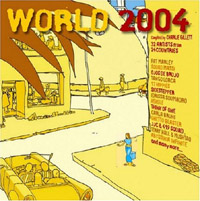 |
WORLD 2004
Compiled by Charlie Gillett (WRASSE 123)
I am not privy to the cult of Charlie Gillett, the BBC radio deejay. Throughout my teens in Britain I was a devotee of John Peel & used to listen to his "Perfumed Garden" show on pirate Radio Caroline until I fell asleep (after years of Radio Luxembourg on the shortwave under the covers). Peel was a world music pioneer but I think he was jockeyed into a more mundane gig by the BBC while they have turned the fringes over to Gillett and other later arrivals. Gillett gets a lot of reverence from blurbists but his own compilation seems diffused and a bit too middle-of-the-road, but you know that's what makes a success sometimes. Besides, this year's music seems average so far and therefore stuff that is only marginally good tends to get noticed. Though it's only mid-2004 Gillett has plumped for a year's worth of music in this round up which spans two CDs. But because it's so long it gets flaccid. The first cut is very intriguing: a Brasilian hip-hop reggae sample with weird found lyrics, including a bit of Bollywood. It's called "Xin" by Fat Marley and then two hours later we get to another ambient dubby thing called "Hope" by Fat Freddy's Drop which nicely ties things up with a big bow. It also shows the global trend towards obesity! In between there are some obvious choices: Ojos de Brujo, Kekele, Tinariwen, Souad Massi, Abyssinia Infinite, Lo'jo. I'm tired of mediocre music and there are abundant slack tracks: the previously unreleased Khaled track "Madre" is bad disco. There's a weird return to Africa by Kanda Bongo Man (now resident in Birmingham, England) where he tackles the sound of Soweto. There's a guy called Gianmaria Testa who thinks he's Paolo Conte. There's a lousy French chanteuse Carla Bruni who does a dated, heavy-breathing thing. More French rap from Ghetto Blaster. C'est terrible! The good news, I suppose, is there's nothing sensational we hadn't heard of, so we are not as far out of the world loop as we feared out here on the Western shelf. The hottest track, "Carolina" by Bucovina Club vs Taraf de Haidouks, is sure-fire top ten material. But not much else is that stellar. There's a good piece from Brasil "A Danca da moda" by DJ Dolores y Orchestra Santa Messa I hadn't heard before, and there's a nice stretch midway through the second disc which has fado and a Venezuelan piece, followed by Taffetas (from Switzerland and Guinea-Bissau.) Other than a tendency to MOR (one flamenco cut by Tango Lorca would fit right in on Radio Three's light classical music roster), this is a decent slice of the year-to-date. Let's hope there's better to come.
|
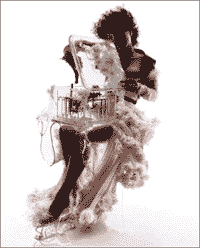 | BJORK
LIVE AT ROYAL OPERA HOUSE (2001)
MTV UNPLUGGED (1994) DVDs
The Duchess turned me onto her favourite pop performer, Björk. This year we got into her concerts on DVD. The Royal Opera House show and MTV Unplugged both bear watching more than once. Like my favourite artist, Thelonious Monk, Björk plays the same songs over and over, but they evolve as she does. More than just a songwriter-singer, she is a real performance artist. Her double-string quartet scores are subtle and rich and her collaborations with Matmos and other groups shows her to have a keen ear for the cutting edge of pop. So forget about the mouldy Monterey Pop box set or other reruns that are being flogged with dubious extra material, and check out something fresh and rather brilliant.
|
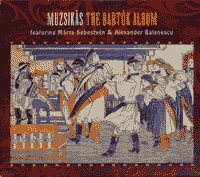 | MUZSIKÁS
THE BARTOK ALBUM (Hannibal HNCD 1439)
Muzsikás have put out a recording that demonstrates a connection between classical and folk music. It's THE BARTOK ALBUM and features snippets of field recordings made by Bela Bartok along with the ensemble's performances of some of his folk-derived pieces. Classical composers have always used vernacular sources and this recording bridges the two genres. Muzsikás are perfectly suited to the task. (I won't be snide and say thank god they did this before Kronos Quartet thought of it, but it's a natural fit for them.)
This album made several critics' top ten lists for 1999 so I won't dwell on it but I think it's the best thing that Muzsikás has done. You can't really trust what you read in the music papers anyway (those lists are generally compiled by Promosexuals -- people who will say or do anything to get free product). So don't take the critics' word for it, check it out!
|
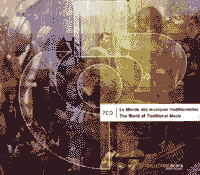 | VARIOUS ARTISTS
OCORA BOX SET (C561061/67 Harmonia Mundi 28X7)
One of the great archives of world music is OCORA, the French national radio. I treasure my OCORA African vinyl and have tried to fill in the blanks as the albums have come out on CD. I have a poet-friend who was kept sane during his years of study at Harvard by the pygmy music of Central Africa on OCORA LPs (that he later went round the bend is not a logical manifestation of his listening to so much tribal music, but we did spend many happy evenings together exploring our collections).
Now there's a sampler box set (originally issued in separate volumes a decade ago) and, apart from the box set collectors who like to buy in bulk, there's a lot to engage you in the seven discs, boiled down from over 300 album releases. Volume one is the Arabic diaspora, starting in Algeria and moving East (most befitting) to Iran. Familiar acts on here are the Gnaoua of Essouira, Morocco and Talip Ozkan of Turkey.
Volume two, South Asia, presents the Indian subcontinent, and from Ravi Shankar to Nusrat it moves faultlessly in a wonderfully sequenced hour of mellow evening music. There's singing from Lakshmi Shankar and some less-well-known classical musicians who are up to the level of the masters.
Volume three is East Asia (China, Korea, Japan), an area I only know from film soundtracks. However I can't say I have ever seen any Korean films. But track 6, by South Korea's Ensemble Jong Nong Ak Ohô, reminded me of the clucking and scratching of avant-garde German guitarist Hans Reichel. The instruments are gomungo and chango (not the Cuban god!). Far out, indeed!
Volume 4, Southeast Asia, has the strangest stuff on it, as well as the familiar gamelan which, for many of us, was our first encounter with music of the rest of the world, thanks to the Nonesuch Explorer series. I once read a critique of world music that said it was marketed to jaded Westerners who were seeking the thrill of something new, but the newness and strangeness of Vietnamese and Burmese music is what makes it inaccessible to me. I don't think I'll ever get used to it, and I seek the comfort of the familiar gamelan tones of Indonesia. There is a big surprise on this album and it's the closing track "In the current of the Mekong" from Laos which sounds like a rocking Cajun two-step. The liner notes call it a bamboo mouth-organ -- the khaen, related to the sheng in China -- it sure is jamming!
For me, Volume 5 (Africa) is the greatest repository of OCORA's riches. Here they charted vast unknown areas of Africa (remember that Hugh Tracey was making his recording trips by truck from his base in South Africa, so he didn't get to Francophone West Africa). OCORA started about a decade later but they were thorough. Their albums also contained booklets with photos and detailed notes. Masques Dan, Ceremonie des Bobe, Polyphonie Mongo -- so many remarkable moments in these discs! We start with Lobi celebration music from Burkina Faso, recorded in 1961: growly, gravelly, wonderous. Musique Gbaya is great meditation music; I also discovered it's great driving music. The African selections have also been released on a single CD as C560065. While it's a great introduction to African traditional music, it has the usual limitations of time. To really get inside these pieces you need the whole length of the album, especially the ritualistic or ceremonial pieces that were already cut down from day-long recordings. This even affects more contemporary music.
One of my all-time favourites is OCORA C559007, "Musiques Urbains à Kinshasa," recorded in November 1978 and released in 1987. It never came out on LP, but the double cassette release is two hours long, while the same four selections are chopped to 73 minutes to fit on the single CD. On the sampler, the track by Tout-Puissant Likembe Konono is only 6 mins and 20 seconds; on the CD it is 26 mins and 50 seconds, while it clocks in at 29'30 on the cassette! What is so compelling about this particular release is its modernity. Here are traditional thumb-piano bands who have made contact mikes out of copper foil and wire, and built amplifiers with scavenged car batteries to generate a raw and ragged sound that is also loud! By recontextualizing their music, these musicians who have migrated from the bush to the burbs have made it vital once more.
Volume 6, Europe, seems to betray a hint of Gallic bias. The bagpipe piece comes from France and there's a Belgian polka. No Celtic music is represented unless someone wants to make a wild connection with Fado. The longest and most outstanding piece here is the "Song of the Innkeeper's Wife" by Taraf de Clejani, a Roumanian gypsy group. I have heard this same piece done by Taraf de Haiduks. There's a horsehair string on the fiddle which, when played briskly, sounds like something ripping. This segues into an uptempo ballad and the music shifts about in movements as different tempos and instruments are featured. After some laments with accordion from Russia, we hear from the master of the Greek bouzouki, followed by the startling triple-reed launedda from Sardinia that requires circular breathing to play. There's no Corsican polyphony, probably to bolster the liner notes' wild claim that polyphonic music originated in the heart of Paris at Notre Dame. (In all likelihood the liner notes are hard to read, at first, being translated perhaps by a machine which, to them, imparts a haphazard personality. Imbued with such difficulties we nevertheless blunder on.) A Spanish bulería and Portuguese fado round things off nicely showing white folks can have soul (though you might argue that 8 centuries of Arab & African blood made them mestizos)!
Last up, Volume 7, takes in Latin America. A different place from the one we know from our favourite familiar Colombian and Brasilian recordings. However there's some weird and wonderful stuff here: like the scene where a wild bull meets a market truck on a jungle track. Actually it's a rare recording made by a tribe of Asurini do Xingu whose rituals are unknown to anthropologists, but they know how to work a tape recorder! It sounds like African horn music too. The instruments are low-pitched tule clarinets and flutes made from reeds and their rhythmic propulsiveness blends in with the insect sounds. This is a must-find (on OCORA 560084). Cuba is so thoroughly documented you know right away what's going on. It's the Family Miranda doing a popular song from the 1940s by Compay Segundo. The other central American tracks have a familiarity in their rhythms and instruments, but overall this OCORA box brings to light some gems in their vast catalogue and is well worthy delving into.
|

